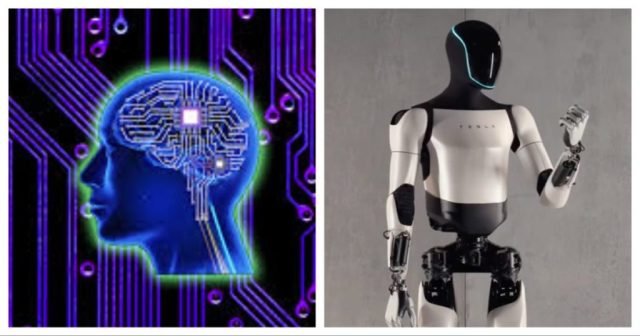In an unusual online exchange, Neuralink’s top surgeon hinted at the company’s next experiment — linking its brain implant to Tesla’s humanoid robot. Experts, however, warn that science may be far from catching up with the spectacle.
A Vision Too Far, Too Fast?
What happens when the speculative frontiers of robotics and neuroscience collide? That question surfaced this week after Neuralink’s head of surgery, Dr. Danish Hussain, suggested on social media that the company’s brain–computer interface could one day control Tesla’s humanoid robot, Optimus.
In a lighthearted post on X, formerly Twitter, Hussain lamented that “so many people think Neuralink is some evil megacorp,” adding that the firm was “just out here helping the homies eat pretzels lol.” His remark referred to a demonstration video shared by another Neuralink staffer, purportedly showing a man operating a slow robotic arm “all via telepathy.”
When a commenter speculated that the same interface could eventually train or guide Tesla’s Optimus robot, Hussain replied, “We’re starting simple, but this will happen very soon.”
The casual tone belied the extraordinary implication: a seamless human-to-robot interface, allowing a person to control a walking machine through thought alone
The Optimus Puzzle: Tesla’s Struggling Prototype
The timing of Hussain’s comments is telling. Tesla’s Optimus robot — showcased by Elon Musk as the future of labor automation — remains a far cry from its lofty promise. Recent demonstrations have shown the robot shuffling haltingly and performing limited, preprogrammed gestures.
Analysts have described Optimus as “an absolute mess,” struggling even to respond in full sentences during staged interactions. Yet Musk has claimed that Optimus will eventually make up “80 percent” of Tesla’s long-term value, part of his sweeping vision to merge robotics, AI, and human consciousness into a single technological ecosystem.
Those ambitions arrive at a turbulent moment for Tesla, which is contending with one of the most difficult financial years in its history and intensifying scrutiny over its self-driving claims.
Neuralink’s Reality Check
Neuralink, meanwhile, has been conducting human trials of its brain-implant technology after receiving U.S. regulatory clearance in 2023. So far, the company has reportedly implanted its device in 12 human test subjects. Results have been uneven.
The company’s first publicly identified patient, Noland Arbaugh, initially celebrated regaining partial control over digital interfaces through the implant — but later admitted that the device “didn’t work so well anymore” after several months of use.
These setbacks highlight the chasm between aspiration and application. While Neuralink touts the potential of brain-computer interfaces to restore mobility and communication, researchers caution that issues of signal stability, immune response, and ethical oversight remain unresolved.
The Musk Formula: Big Promises, Bigger Questions
For critics, Hussain’s comments fit a familiar pattern — what one investor called “the Musk formula”: announce a future-defining breakthrough long before the underlying science is ready. From Mars colonization to full self-driving cars, Musk has long relied on audacious projections to bolster investor confidence and public intrigue.
Yet integrating Neuralink’s implants with a humanoid robot introduces not just engineering hurdles but profound ethical and philosophical ones. The idea of telepathically commanding a machine blurs distinctions between autonomy and control, human agency and corporate ambition.
Still, for Musk’s followers and Neuralink’s supporters, the dream persists: a future where thought and motion merge, and the boundary between biology and machinery fades.


